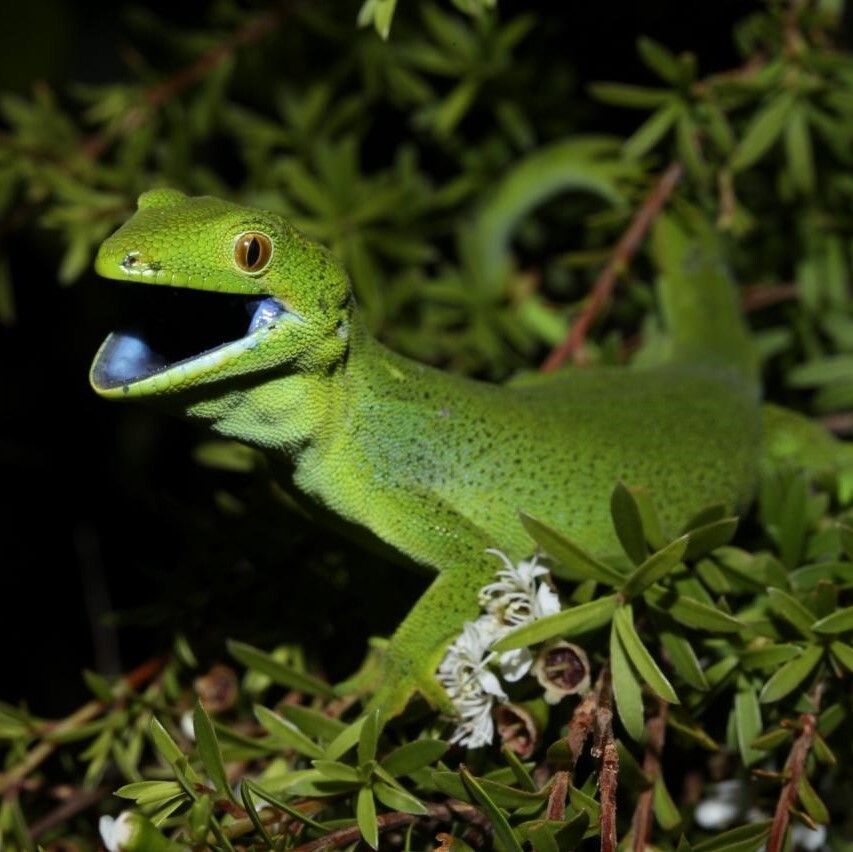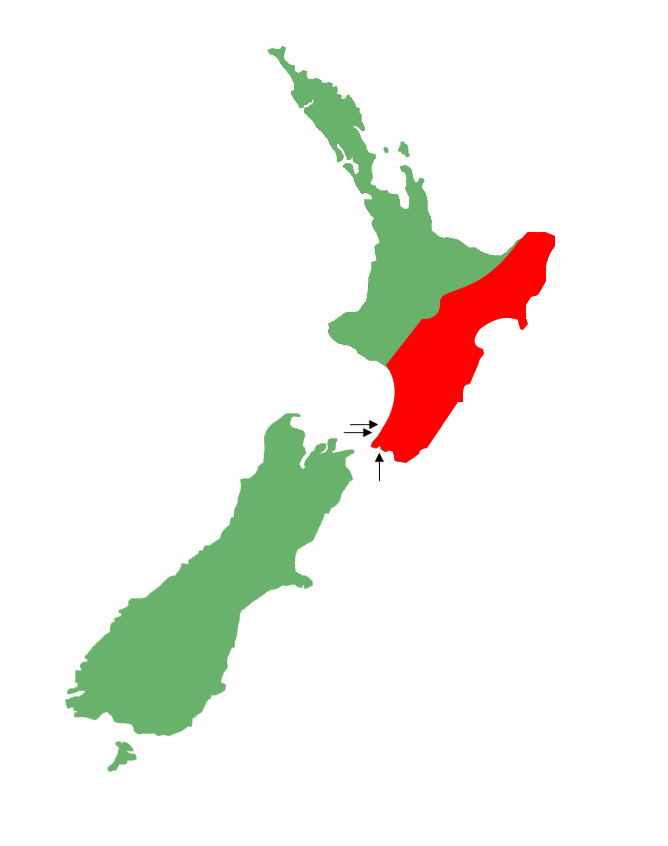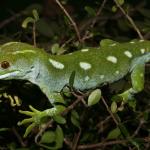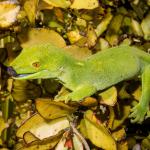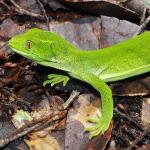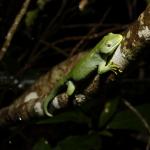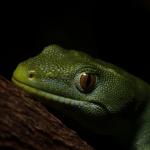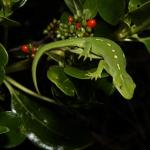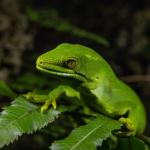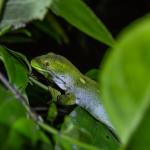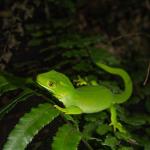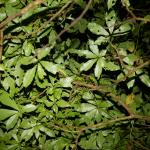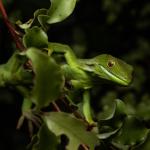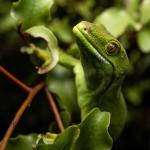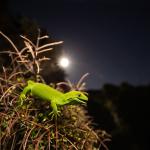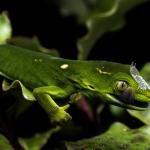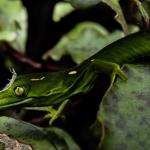- Home
- Herpetofauna Index
- Native
- Naultinus Punctatus
Naultinus punctatus
Barking gecko | Moko kākāriki
Naultinus punctatus
(Gray, 1843)

Length: SVL up to 95mm, with the tail being longer than the body length
Weight: unknown
Description
A robust species of green gecko, found in the forested regions of the southern North Island of Aotearoa/New Zealand. Although often lacking the beautiful white dorsal patternings found in many of Aotearoa's green geckos, mature males make up for this by sporting beautiful pale blue flanks. Barking geckos - along with the Northland green gecko (Naultinus grayii) - are regarded as the largest species amongst Aotearoa's green geckos (Naultinus).
These geckos are characterised by their bright to pale green upper surfaces, which in some individuals are broken up by white or yellowish markings (either striped, blotched, or a combination of both). The sides of the animals are much the same as the upper surfaces, although are typically flushed with a pale blue colouration in mature males. Their mouth is often bordered below by a white stripe which typically terminates at the edge of the mouth, but may continue onto the opening of the ear. The ventral colour is pale green, sometimes with a yellow tinge, although some males exhibit a blue-tinged stomach.
Mouth and tongue colour is typically a key feature in distinguishing between North Island Naultinus species, however, the barking and elegant gecko (Naultinus elegans) share the combination of a deep blue mouth with a black tongue. Interestingly, barking geckos seem to have issues regrowing their tails once dropped, resulting in a strange toilet plunger-esque tail.
Xanthochromic (yellow) individuals have been reported.
Can be differentiated from Northland green (Naultinus grayii) and Aupōuri geckos (Naultinus flavirictus) by a black (versus red) tongue, as well as by a blue (versus lilac/pink) mouth colour for the latter. Barking geckos are extremely similar in appearance to the elegant gecko (Naultinus elegans), but can typically be differentiated by a combination of size (≤95mm vs. ≤75mm SVL), foot colouration (yellow vs. green), and patterning (often sparsely patterned vs. often patterned). Past hybridisation with the elegant gecko (N. elegans) at the northern extent of their range, may have resulted in a mixing of traits in those populations.
Life expectancy
Barking geckos have been recorded reaching ages of ~25 years in captivity, but are likely to exceed this.
Captive green geckos have frequently been known to live for upwards of 25 years, with some individuals topping the records at 50+ (D. Keal pers. comm 2016). In the wild, green geckos have been recorded as reaching a minimum of ~15 years, although it is likely to be more than this given that the population in question was only monitored from 2009, and those animals are still alive (C. Knox pers. comm 2021).
Distribution
Restricted to the southern North Island, with the northern extent seemingly bounded by the Whanganui river, and mountain ranges running towards the East Cape (Tongariro to the Raukumara Ranges). Occurs on three islands off the South-western coast of the North Island; including one natural population (Kapiti Island), and two translocated ones (Mana Island, and Matiu/Somes Island).
Ecology and habitat
The barking gecko appears to be cathemeral (active both day and night) in nature, although predominantly considered diurnal (day-active), due to its strongly heliothermic nature (being an avid sun basker). As with all members of the Naultinus genus they are primarily arboreal (tree-dwelling), although can at times be found quite low to the ground in prostrate (ground hugging) vegetation. Although seldom seen on the ground, males can be found travelling between trees in search of mates during the breeding season. As with all green geckos, they possess a strongly prehensile tail which acts as a third-limb/climbing aid when moving through shrubs and trees. They are known to mouth gape and produce a barking sound as a defensive behaviour against potential predators.
Being an arboreal species, barking geckos are closely associated with forested habitats, and thus inhabit a wide variety of forest types in the south-eastern North Island, including swamps, scrubland, sub-alpine scrub, and mature forest. They appear to favour scrubby/regenerating habitats, but this may be a result of the relative ease of access to, and amount of search effort that these sites garner.
Social structure
The barking gecko is solitary in nature, although can be found at fairly large densities in some habitats. Males show aggressive behaviour toward congeners, especially during the breeding season, and this is easily observable with many males showcasing scarring over their bodies. Mate guarding seems to occur in this species, with males often found in close proximity to females prior to birthing. Although independent at birth, neonates (babies) are often found together and close to the mother for the first few months of life.
Breeding biology
Like all of Aotearoa's gecko species, the barking gecko is viviparous, giving birth to one or two live young annually, from around Late March through to May. Breeding seems to occur from July through to September, with males performing mate guarding, and following females around. The gestation period is around 7.5 months.
As is the case with many lizard species, mating in green geckos may seem rather violent with the male repeatedly biting the female around the neck and head area. Sexual maturity is reached between 1.5 to 2 years.
Diet
Barking geckos are omnivores. They are primarily insectivorous in nature, but are also known to feed on the nectar, and small fruits of several plant species, and the honeydew of scale insects when they are seasonally available. Being arboreal in nature, their invertebrate prey tends to be predominantly composed of flying insects (moths, flies, beetles), and small spiders.
Disease
The diseases and parasites of Aotearoa's reptile fauna have been left largely undocumented, and as such, it is hard to give a clear determination of the full spectrum of these for many species.
The barking gecko, as with many of our other Naultinus species, is a host for at least one species of endoparasitic nematodes in the Skrjabinodon genus (Skrjabinodon poicilandri), as well as at least one strain of Salmonella. Similarly, it is unlikely to be a host for ectoparasitic mites in the wild. Captive collections have been known to host mites, but these have likely shifted onto the animals from different species e.g. Mokopirirakau, Dactylocnemis, and Hoplodactylus geckos.
Wild green geckos have been found with pseudobuphthalmos (build-up of liquid in the spectacle of the eye) and Disecdysis (shedding issues).
Conservation status
Listed in the most recent threat classification as 'At Risk - Declining', due to a mix of land development/clearance of habitat, and predation by mammalian predators. Effective predator control in the Wellington region is likely to result in a resurgence of this species, and may provide opportunities to translocate them into areas they have disappeared from (depending on pet cat populations in those areas).
Interesting notes
The specific name 'punctatus' references the black speckling that is sometimes present on the dorsal surfaces of this species. Whilst its common name refers to its tendency to make loud vocalisations - similar to other members of the Naultinus genus.
Interestingly, this species may have been the first native lizard to be kept in captivity. William Colenso (1811-1899) kept a small group of these animals (which at the time he called Naultinus pentagonalis) that had been collected from Tikokino (formerly Hampden). These animals subsequently gave birth to young and were studied over a two-year period.
Genetic studies looking at the Naultinus genus resulted in a phylogenetic and taxonomic review in 2011, with the elegant gecko (Naultinus elegans) and barking gecko being elevated from subspecies to full species status.
The barking gecko is the sister species to the Elegant gecko (Naultinus elegans). The Northland green gecko (Naultinus grayii) being the sister taxa to those species, and the Aupōuri gecko (Naultinus flavirictus) being a more distant relative.
References
Fischer, S.M. (2013). Conservation biology and wildlife management in New Zealand: endemic reptile species, urban avifauna, and wetland ecology (unpublished BSc honours dissertation). Massey University: Auckland, New Zealand.
Gill, B.J., & Whitaker, A.H. (1996). New Zealand frogs and reptiles. Auckland: David Bateman Limited.
Jewell, T. (2011). A photographic guide to reptiles and amphibians of New Zealand. Auckland: New Holland Publishers Ltd.
Robb, J. (1980). New Zealand amphibians and reptiles in colour. Auckland, New Zealand: Collins.
van Winkel, D., Baling, M. & Hitchmough, R. (2018). Reptiles and Amphibians of New Zealand: A field guide. Auckland: Auckland University Press, 376 pp.

